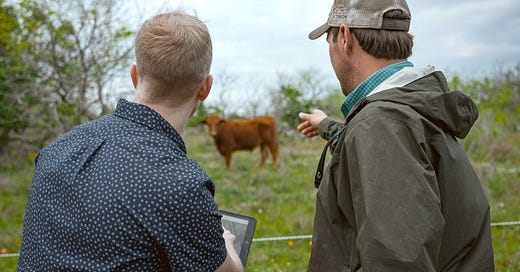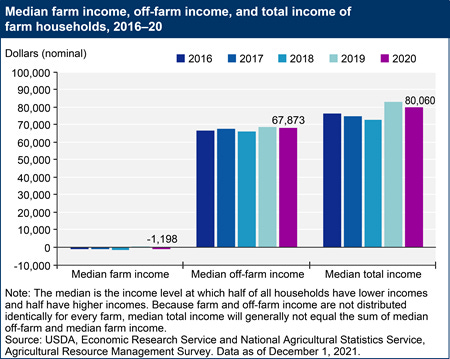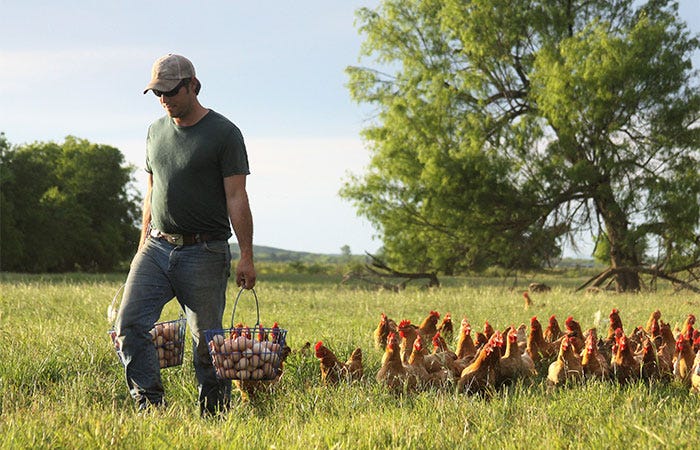💰How Does Carbon Credit Revenue Impact Ranchers?
Last week, Soilworks portfolio company Grassroots Carbon announced its first tranche of rancher payments for delivered soil carbon credits, the first of its kind for delivered credits to ranchers (various groups have provided transition finance of some sort with expected carbon credit outcomes.) While the quality of soil carbon credits and the increasing prominence in carbon credit buyer portfolios have been previously discussed by us here at The Regeneration Weekly, we must endeavor to understand how putting cash in ranchers’ pockets changes the attractiveness of the profession - and incentivizes a shift to regenerative practices on each ranch.
To set the scene, I spoke to one particular rancher in the Grassroots program - Travis Krause, the CEO of ranch management company Grazing Lands. Travis is an affable representative for the younger generation, inspired by the regenerative frameworks of Joel Salatin, Will Harris, and André Voisin, that returned back to family ranches looking to shake things up. After working as a biologist in India studying livestock parasites, Travis set up a poultry and cattle operation on his family property, Parker Creek Ranch, developing one of the first pastured poultry programs in Texas across 3,700 leased and owned acres. The struggles of being a regenerative farmer were apparent from his first few years of operating. As he put it in a 2019 interview, “You have to be not just a livestock producer and manager, but you have to be an accountant and a web designer, a salesperson, and all these other things to be successful. And that’s easier said than done.” Ranchers and farmers, especially those operating independent and small family farms, live on extreme precarity. For this “changing guard” focused on holistic management and without the financial cushions of larger operations, “the trick of it is figuring out how to make these farms financially viable…We’ve just got to make sure we’re not the new starving artists of our generation…we’ve got to make sure this works for people,” as Travis stated.
Many small farms are not profitable in even the best agricultural income years and frequently rely on off-farm income, hunting, and tourism to cover for running operations at a loss. Median off-farm income in 2020 was $67,873, while the median total household income was $80,060 according to the USDA ERS. Median household income from farming was -$1,198 in 2020, though we should note 89% of US farms are small (gross cash farm income <$350,000). These farms account for over a third of total US farm production and over half of all farm assets. It’s a grim picture for any burgeoning farmer who wishes to make a difference: in what other professions do 50% of the practitioners lose money doing what they do for over a generation? Whatever answer one may scrounge up, those don’t tend to be the jobs you encourage young folks to take up.
Travis trudged through and eventually founded Grazing Lands to prove the regenerative grazing model at scale in Texas. His first property under management, Pajarito Ranch, is both a laboratory and a model for how to achieve that vision. As Travis has put it in his own great blog, The Pastoralist, regenerative agriculture must scale to be economically competitive. However, bringing down direct and overhead costs in order to achieve an economy of scale is a daunting task.
It’s in this particular niche space that carbon credits matter for a regenerative grazing operation. In a Corteva-backed survey, farmers started becoming interested in carbon programs when the payout was $20/acre and a majority would commit at nearly $40/acre (storage per acre varies across geographies and practices adopted). Farmers are willing to adopt carbon credit programs for the right financial incentives. Given that soil carbon removal-based credits have skyrocketed since COP26, we are well on our way to go from that interest price-point to enrollment price-point, though I’ll briefly note that data and payment flows need more standardization and farmers should scrutinize every carbon credit contract as they would any other binding legal agreement.
Travis and Pajarito will receive nearly $20,000 this year in carbon revenue, an amount which can prospectively go upwards 4x for 2022. This is because of a significant increase in prices and a revenue cost-share model Grassroots has for the initial meter-deep sampling baseline (Grassroots foots the bill, but the cost of measurement per acre gets paid back to Grassroots). He intends to re-invest the money in the necessary infrastructure for the farm: water pipelines for each pasture, electric fencing to do moves without disturbing the land, and identification tags for cattle. However, as a businessman, carbon credit revenue will allow him to graze for carbon and ecosystem services, not just animal daily weight gain and performance. “It’s a whole other ball game”, as Travis puts it, and in scoping out new potential collaborations and properties, he considers carbon credits a key revenue driver. Though carbon credit prices will fluctuate, diversifying revenue streams will allow ranch economics to rely less on live cattle prices. Carbon credits have the potential to change the beef industry, be it through soil carbon credits or methane-reduction credits that CAFOs will adopt, but the convergence between the land industry and regenerative land stewardship will become more and more important.
Novel structures, like natural asset companies, carbon credit project developers including Grassroots Carbon, and non-dilutive government money such as the Climate-Smart Commodities program, will bring investment capital towards the agricultural carbon credit economy. Making sure this money flows to the land operators themselves who will re-invest the capital into their land and scale their practice, is paramount. A constant worry to me about the ecosystem service world is that we will have a massive land grab based on ecosystem service potential and the folks best trained and most aligned with regenerative land management will be priced out of doing so. Rather, we need to use this emerging market to provide cash flow and access to capital to scale for regenerative ranchers. Delivering carbon credits and seeing how the revenue directly impacts ranchers’ profitabilities and livelihoods is the best first step.
Disclaimer: The Regeneration Weekly receives no compensation or kickbacks for brand features - we are simply showcasing great new regenerative products.
If you have any products you would like to see featured, please respond to this newsletter or send an email to Kevin(at)soilworksnaturalcapital.com
The Regeneration is brought to you by Wholesome Meats | Soilworks | Grassroots Carbon| Grazing Lands







